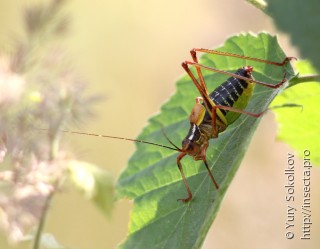Barbitistes constrictus Brunner von Wattenwyl, 1878

Taxonomy
class Insecta → subclass Pterygota → infraclass Neoptera → superorder Polyneoptera → order Orthoptera → suborder Ensifera → infraorder Tettigoniidea → superfamily Tettigonioidea → family Tettigoniidae → genus Barbitistes → species Barbitistes constrictus
Species name(s)
Barbitistes constrictus Brunner von Wattenwyl, 1878 = Barbitistes constrictus oltenicus Kis, 1960 = Barbitistes oltenicus Kis 1960. [187]
urn:lsid:insecta.pro:taxonomy:516320
Expansion
This species marks on the maps: 1.
Zoogeographical regions
Palaearctic.
Flight time
| January | February | March | April | May | June | July | August | September | October | November | December |

Detailed information with references
Distribution
- Central and Eastern Europe — Germany, the Carpathians, Western and Southern Ukraine, Belarus, north-west and middle zone of European Russia from Novgorod region east to Murom Vladimir region [260].
Imago Habitus and Differences from alike species
- The body length of the male is 14-16 mm, the female-16-20 mm (ovipositor-9.8-11 mm). A mottled, flightless grasshopper. The body is brownish-red or greenish, covered with dark dots and light stripes. The antennae are brown or black, with sparse whitish rings. The top of the pronotum is black or brownish-black, with a thin light median line and a broad light stripe on the sides. There are two rows of yellow spots along the top of the abdomen. The lower abdomen is black. The elytra are shortened, red in the male and green in the female, with a yellow border on the outside. A yellow stripe runs along the bottom of the hind thighs. [265].
General info about Imago
- It inhabits old-growth pine forests with vegetation and entomocomplex characteristic of white-moth and green-moth pine forests. As a rule, it is found on well-lit pines with a developed crown on the edges of the forest. Active in the evening and at night. Males, as a rule, are located in the crowns of old-growing pines. The species-specific signals of males are in the ultrasonic range. Females periodically (at night) descend to the ground to lay eggs, so they are sometimes found in the morning on the tops of young pines growing near old-growth ones. [260].
Imago food plants / other food objects
- It feeds on pine needles, apical buds, and the bark of young pine branches and shoots. It is also noted that heather, veynik, bracken fern, spruce needles, raspberry leaves, boneberry, horse sorrel feed. [260].
General info about Larva
- Larvae appear in May. [260].
Egg
- A clutch of 2-3 eggs is placed in dry sand, plant litter and bundles of dry grass. It is possible to lay eggs in cracks in the pine bark at some height from the ground. [260].
Authors
Initial species uploading to the site: Peter Khramov.
Photos:
Yury Sokolkov. Text data: Vasiliy Feoktistov.
The species characteristics formalization: Peter Khramov, Vasiliy Feoktistov.
References
- [187] Species 2000, http://www.sp2000.org
- [260] ИАС «ООПТ РФ» ООПТ России ФГБУ "ААНИИ", Лаборатория геоинформационных технологий http://oopt.aari.ru/
- [265] Илья Забалуев Энциклопедия насекомых ©Phoenix WebMaster 2006 - 2012 http://coleop123.ru/
Comments
Note: you should have a Insecta.pro account to upload new topics and comments. Please, create an account or log in to add comments
Barbitistes constrictus photos
Other species Barbitistes









